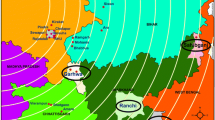Abstract
Tribal communities constitute about 8.2% of the total population of India. Their health needs are even larger than elsewhere in India; this study investigates the genetic diversity in relation to hemoglobinopathies, G6PD deficiency and, ABO and Rhesus (D) blood groups in two sects, i.e. Dudh (converted Christian) and Dhelki (Hinduised) Kharia, a primitive tribe in Sundargarh district of Orissa in Central-Eastern India. A randomized screening of 767 Kharia tribals (377 males and 390 females) belonging to all age groups and both sexes was done. Laboratory analysis was carried out following the standard methodology and techniques. Contrasting differences were observed in the frequency of hematological genetic disorders such as β-thalassemia, sickle cell, hemoglobin E, G6PD deficiency, ABO and Rhesus (D) blood groups between the two subgroups. Dudh Kharia had no hemoglobin variant allele other than the high prevalence of β-thalassemia trait (8.1%), whereas, their counterpart Dhelki Kharia had the high prevalence of sickle cell allele (12.4%), hemoglobin E allele (3.2%), and β-thalassemia allele (4.0%). Frequency distribution of hemoglobin variants between Dudh and Dhelki Kharia tribe was statistically highly significant (p < 0.001). High G6PD deficiency was detected 19.2% and 30.7% in Dudh Kharia and Dhelki Kharia, respectively (p < 0.001), the average being 24.4% in Kharia tribe. Kharia tribes show a trend for replacement of sickle cell gene with G6PD-deficiency gene as the clinical manifestations of G6PD deficiency are mild (do not result in a complete loss of enzyme activity) against the sickle cell disease with high morbidity and mortality. Rhesus (D)-negative blood group was 1.1% in Dudh Kharia and absent in Dhelki Kharia (p < 0.05). This study showed genetic isolation of the two sects of Kharia tribe. Antimalarial drugs administration needs to be done with caution. Hematological disorders pose a major health challenge having multifaceted implications in public health genetics.
Similar content being viewed by others
References
Balgir RS (1995) Genetic markers in the tribal health, development and welfare with special reference to North-Eastern India. In: Sharma JC (ed) Anthropology, population and development. Inter-India, New Delhi, pp 151–171
Balgir RS (1999) Control and prevention of the genetic load of hemoglobinopathies in India. Natl Med J India 12:234–238
Balgir RS (2000) Human genetics, health and tribal development in Orissa. In: Dash Sharma P (ed) Environment, health and development: an anthropological perspective. SC Roy Institute of Anthropological Studies, Ranchi, pp 87–104
Balgir RS (2001) Prevention of hereditary disorders in India: sickle cell disease, β-thalassemia and G6PD deficiency. Division of Human Genetics, Regional Medical Research Centre (ICMR), Bhubaneswar, pp 1–12
Balgir RS (2003) Prevalence of abnormal hemoglobin E gene in the Dhelki Kharia tribal population. Curr Sci 85:1604–1608
Balgir RS (2004) Health care strategies, genetic load and prevention of hemoglobinopathies in tribal communities in India. S Asian Anthropologist 4:189–198
Balgir RS (2005a) The spectrum of hemoglobin variants in two scheduled tribes of Sundargarh district in North-Western Orissa, India. Ann Hum Biol 32:560–573
Balgir RS (2005b) Emerging trends in genetic epidemiology of hemoglobinopathy in the seven sister states of North Eastern India. In: Das RK, Basu D (eds) North East India in perspectives: biology, social formation and contemporary problems. Akansha, New Delhi, pp 17–37
Balgir RS (2006) Do tribal communities show inverse relationship between sickle cell disorders and glucose-6-phosphate dehydrogenase deficiency in malaria endemic areas of Central-Eastern India? Homo-J Comp Hum Biol 57:163–176
Balgir RS (2007a) Infant mortality and reproductive wastage associated with different genotypes of hemoglobinopathies in Orissa, India. Ann Hum Biol 34:16–25
Balgir RS (2007b) Challenges of imparting IEC for prevention of hereditary sickle cell disorders, β-thalassemia syndrome and G-6-PD deficiency in India. Tribal Health Bull 13:14–22
Balgir RS (2008) Hematological profile of twentynine tribal compound cases of hemoglobinopathies and G-6-PD deficiency in rural Orissa. Ind J Med Sci 62:364–373
Balgir RS, Sharma JC (1988) Genetic markers in the Hindu and Muslim Gujjars of Northwestern India. Am J Phys Anthropol 75:391–403
Balgir RS, Mishra RK, Murmu B (2003) Clinical and hematological profile of hemoglobinopathies in two tribal communities of Sundargarh district in Orissa, India. Int J Hum Genet 3:209–216
Bernstein RE (1962) A rapid screening dye test for detection of G6PD deficiency in red cells. Nature 194:192
Beutler E, Blune EG, Kaplan JC, Lohr GW, Ramot B, Valentine WW (1979) International committee for standardization in hematology recommended screening test for glucose-6-phosphate dehydrogenase deficiency. Br J Haematol 43:465–467
Bhasin MK, Walter H (2001) Genetics of castes and tribes of India. Kamla-Raj Enterprises, Delhi, pp 26–78
Dacie JV, Lewis SM (1991) Practical hematology, 7th edn. Churchill Livingstone, Edinburgh, pp 227–258
Kaur M, Das GP, Verma IC (1997) Sickle cell trait and disease among tribal communities in Orissa, Madhya Pradesh and Kerala. Indian J Med Res 105:111–116
Sinha BN (1987) Adivasi Atlas of Orissa. Vol. I. Department of Harijan and Tribal Welfare, Govt. of Orissa, Bhubaneswar
Weatherall DJ (1983) The Thalassemias. In: Weatherall DJ (ed) Methods in hematology vol. 6. Churchill Livingstone, New York, pp 27–53
WHO Report (1967) Standardization of procedures for study of glucose-6-phosphate dehydrogenase deficiency. World Health Organ Tech Rep Ser 366:1–53
Acknowledgements
Author acknowledges the financial support from the Ministry of Health and Family Welfare, Government of India through the Indian Council of Medical Research (ICMR), New Delhi. Author is grateful to Dr. V. M. Katoch, Secretary (Department of Health Research, Government of India) and Director General, ICMR, New Delhi for providing the necessary facilities. Thanks are due to CDMO, DWO, and PHC doctors, community leaders of Kharia tribes for their kind cooperation. Thanks are also due to Mr. R. K. Mishra, Laboratory Technician for his support in the field and laboratory work.
Author information
Authors and Affiliations
Corresponding author
Rights and permissions
About this article
Cite this article
Balgir, R.S. Genetic diversity of hemoglobinopathies, G6PD deficiency, and ABO and Rhesus blood groups in two isolates of a primitive Kharia Tribe in Sundargarh District of Northwestern Orissa, India. J Community Genet 1, 117–123 (2010). https://doi.org/10.1007/s12687-010-0016-y
Received:
Accepted:
Published:
Issue Date:
DOI: https://doi.org/10.1007/s12687-010-0016-y




